An Analysis of PMBOK and Agile Project Management Approaches
VerifiedAdded on 2020/12/30
|13
|3122
|490
Report
AI Summary
This report provides a detailed comparison between the PMBOK (Project Management Body of Knowledge) and Agile project management methodologies. It begins with an executive summary highlighting the core differences and objectives. The report then introduces both methodologies, explaining the five process groups and ten knowledge areas of PMBOK, and the iterative, adaptive nature of Agile, including its core principles and the SCRUM framework. A comprehensive analysis follows, contrasting the two approaches, discussing their applicability in various project types, and examining their strengths and weaknesses. The report explores the project management processes of PMBOK, including initiating, planning, executing, monitoring and controlling, and closing phases. It also delves into the knowledge areas like scope, time, cost, and risk management. In contrast, it explains the Agile approach, its emphasis on continuous feedback, and the SCRUM framework, including its roles, events, and deliverables. The report concludes by providing insights into the practical applicability of each method, helping project managers choose the most suitable approach based on project requirements. The report, contributed by a student, is published on Desklib, a platform providing AI-based study tools.
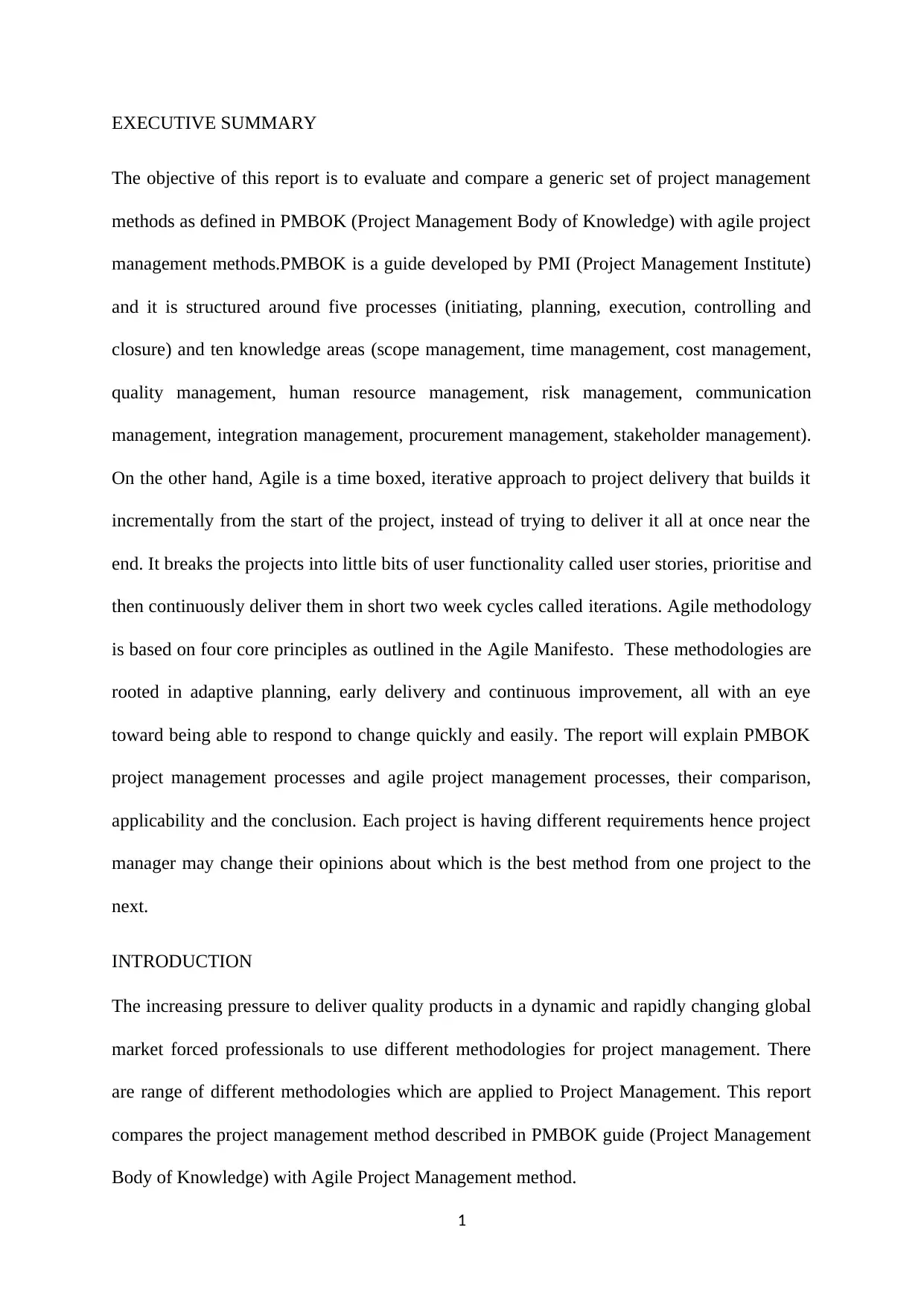
EXECUTIVE SUMMARY
The objective of this report is to evaluate and compare a generic set of project management
methods as defined in PMBOK (Project Management Body of Knowledge) with agile project
management methods.PMBOK is a guide developed by PMI (Project Management Institute)
and it is structured around five processes (initiating, planning, execution, controlling and
closure) and ten knowledge areas (scope management, time management, cost management,
quality management, human resource management, risk management, communication
management, integration management, procurement management, stakeholder management).
On the other hand, Agile is a time boxed, iterative approach to project delivery that builds it
incrementally from the start of the project, instead of trying to deliver it all at once near the
end. It breaks the projects into little bits of user functionality called user stories, prioritise and
then continuously deliver them in short two week cycles called iterations. Agile methodology
is based on four core principles as outlined in the Agile Manifesto. These methodologies are
rooted in adaptive planning, early delivery and continuous improvement, all with an eye
toward being able to respond to change quickly and easily. The report will explain PMBOK
project management processes and agile project management processes, their comparison,
applicability and the conclusion. Each project is having different requirements hence project
manager may change their opinions about which is the best method from one project to the
next.
INTRODUCTION
The increasing pressure to deliver quality products in a dynamic and rapidly changing global
market forced professionals to use different methodologies for project management. There
are range of different methodologies which are applied to Project Management. This report
compares the project management method described in PMBOK guide (Project Management
Body of Knowledge) with Agile Project Management method.
1
The objective of this report is to evaluate and compare a generic set of project management
methods as defined in PMBOK (Project Management Body of Knowledge) with agile project
management methods.PMBOK is a guide developed by PMI (Project Management Institute)
and it is structured around five processes (initiating, planning, execution, controlling and
closure) and ten knowledge areas (scope management, time management, cost management,
quality management, human resource management, risk management, communication
management, integration management, procurement management, stakeholder management).
On the other hand, Agile is a time boxed, iterative approach to project delivery that builds it
incrementally from the start of the project, instead of trying to deliver it all at once near the
end. It breaks the projects into little bits of user functionality called user stories, prioritise and
then continuously deliver them in short two week cycles called iterations. Agile methodology
is based on four core principles as outlined in the Agile Manifesto. These methodologies are
rooted in adaptive planning, early delivery and continuous improvement, all with an eye
toward being able to respond to change quickly and easily. The report will explain PMBOK
project management processes and agile project management processes, their comparison,
applicability and the conclusion. Each project is having different requirements hence project
manager may change their opinions about which is the best method from one project to the
next.
INTRODUCTION
The increasing pressure to deliver quality products in a dynamic and rapidly changing global
market forced professionals to use different methodologies for project management. There
are range of different methodologies which are applied to Project Management. This report
compares the project management method described in PMBOK guide (Project Management
Body of Knowledge) with Agile Project Management method.
1
Paraphrase This Document
Need a fresh take? Get an instant paraphrase of this document with our AI Paraphraser
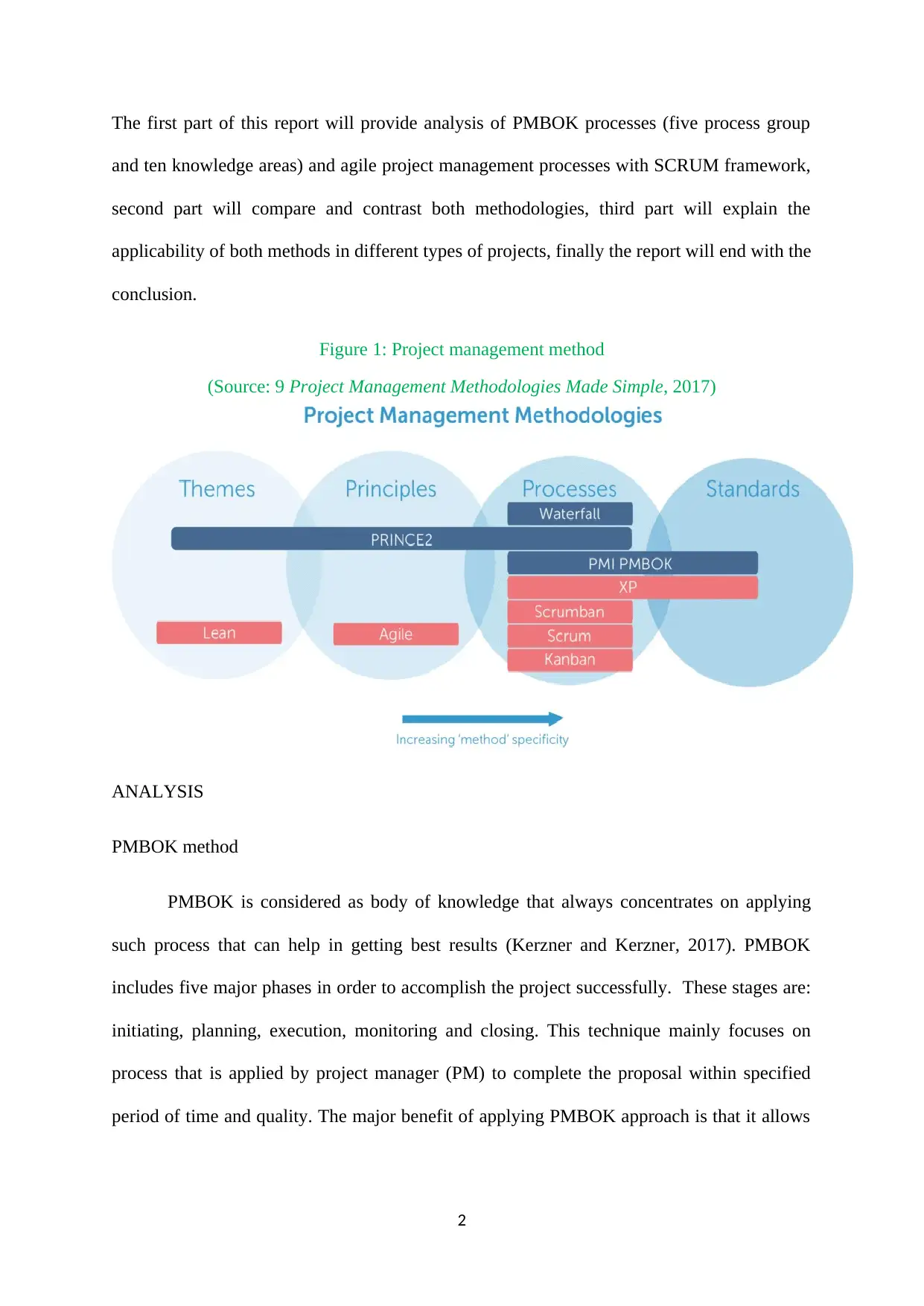
The first part of this report will provide analysis of PMBOK processes (five process group
and ten knowledge areas) and agile project management processes with SCRUM framework,
second part will compare and contrast both methodologies, third part will explain the
applicability of both methods in different types of projects, finally the report will end with the
conclusion.
Figure 1: Project management method
(Source: 9 Project Management Methodologies Made Simple, 2017)
ANALYSIS
PMBOK method
PMBOK is considered as body of knowledge that always concentrates on applying
such process that can help in getting best results (Kerzner and Kerzner, 2017). PMBOK
includes five major phases in order to accomplish the project successfully. These stages are:
initiating, planning, execution, monitoring and closing. This technique mainly focuses on
process that is applied by project manager (PM) to complete the proposal within specified
period of time and quality. The major benefit of applying PMBOK approach is that it allows
2
and ten knowledge areas) and agile project management processes with SCRUM framework,
second part will compare and contrast both methodologies, third part will explain the
applicability of both methods in different types of projects, finally the report will end with the
conclusion.
Figure 1: Project management method
(Source: 9 Project Management Methodologies Made Simple, 2017)
ANALYSIS
PMBOK method
PMBOK is considered as body of knowledge that always concentrates on applying
such process that can help in getting best results (Kerzner and Kerzner, 2017). PMBOK
includes five major phases in order to accomplish the project successfully. These stages are:
initiating, planning, execution, monitoring and closing. This technique mainly focuses on
process that is applied by project manager (PM) to complete the proposal within specified
period of time and quality. The major benefit of applying PMBOK approach is that it allows
2

business to implement standardise practices and maintain standards. This helps in minimising
risk and managing sudden constrains significantly.
Figure: PMBOK process group
(Source: The 5 PMBOK Process Groups, 2012)
In the initiation phase, manager has to define aim and objective of particular project.
Individual has to start new task by obtaining authorization for this task (Rodriguez
and et.al., 2017).
In planning phase, PM has to establish scope and has to refine the actual objectives.
Individual has to schedule all activities so that project can be completed on time and
with quality.
Executing: It is the next stage in which all the planning that has been done of PM is
being executed in order to satisfy specification of project.
Monitoring and controlling: It is the phase in which manager has to monitor
activities and have to control over it. They have to identify necessary areas that
require changes or improvement so that issues can be minimised, and project can be
accomplished with quality (Landry and McDaniel, 2015).
3
risk and managing sudden constrains significantly.
Figure: PMBOK process group
(Source: The 5 PMBOK Process Groups, 2012)
In the initiation phase, manager has to define aim and objective of particular project.
Individual has to start new task by obtaining authorization for this task (Rodriguez
and et.al., 2017).
In planning phase, PM has to establish scope and has to refine the actual objectives.
Individual has to schedule all activities so that project can be completed on time and
with quality.
Executing: It is the next stage in which all the planning that has been done of PM is
being executed in order to satisfy specification of project.
Monitoring and controlling: It is the phase in which manager has to monitor
activities and have to control over it. They have to identify necessary areas that
require changes or improvement so that issues can be minimised, and project can be
accomplished with quality (Landry and McDaniel, 2015).
3
⊘ This is a preview!⊘
Do you want full access?
Subscribe today to unlock all pages.

Trusted by 1+ million students worldwide
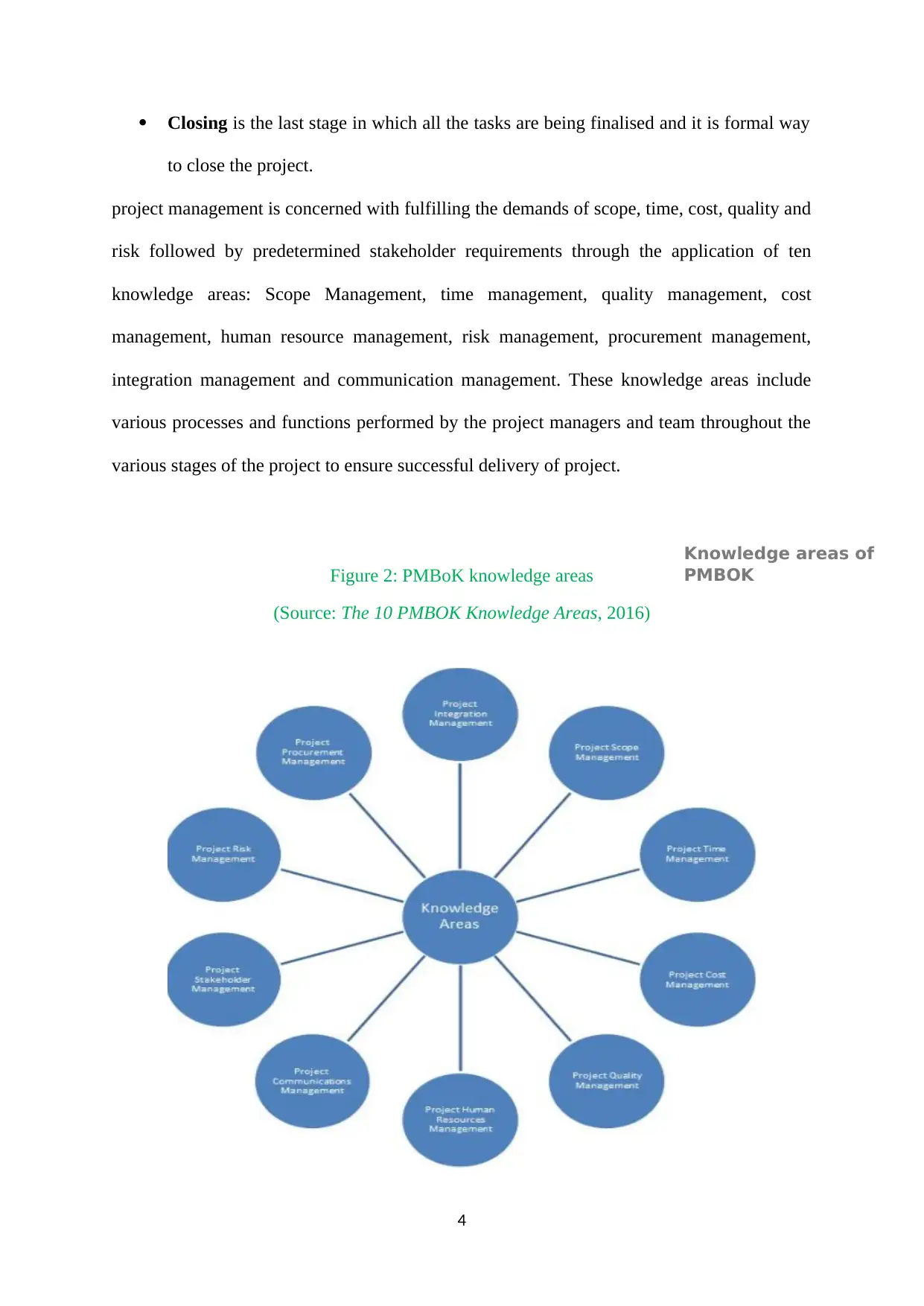
Closing is the last stage in which all the tasks are being finalised and it is formal way
to close the project.
project management is concerned with fulfilling the demands of scope, time, cost, quality and
risk followed by predetermined stakeholder requirements through the application of ten
knowledge areas: Scope Management, time management, quality management, cost
management, human resource management, risk management, procurement management,
integration management and communication management. These knowledge areas include
various processes and functions performed by the project managers and team throughout the
various stages of the project to ensure successful delivery of project.
Figure 2: PMBoK knowledge areas
(Source: The 10 PMBOK Knowledge Areas, 2016)
4
Knowledge areas of
PMBOK
to close the project.
project management is concerned with fulfilling the demands of scope, time, cost, quality and
risk followed by predetermined stakeholder requirements through the application of ten
knowledge areas: Scope Management, time management, quality management, cost
management, human resource management, risk management, procurement management,
integration management and communication management. These knowledge areas include
various processes and functions performed by the project managers and team throughout the
various stages of the project to ensure successful delivery of project.
Figure 2: PMBoK knowledge areas
(Source: The 10 PMBOK Knowledge Areas, 2016)
4
Knowledge areas of
PMBOK
Paraphrase This Document
Need a fresh take? Get an instant paraphrase of this document with our AI Paraphraser
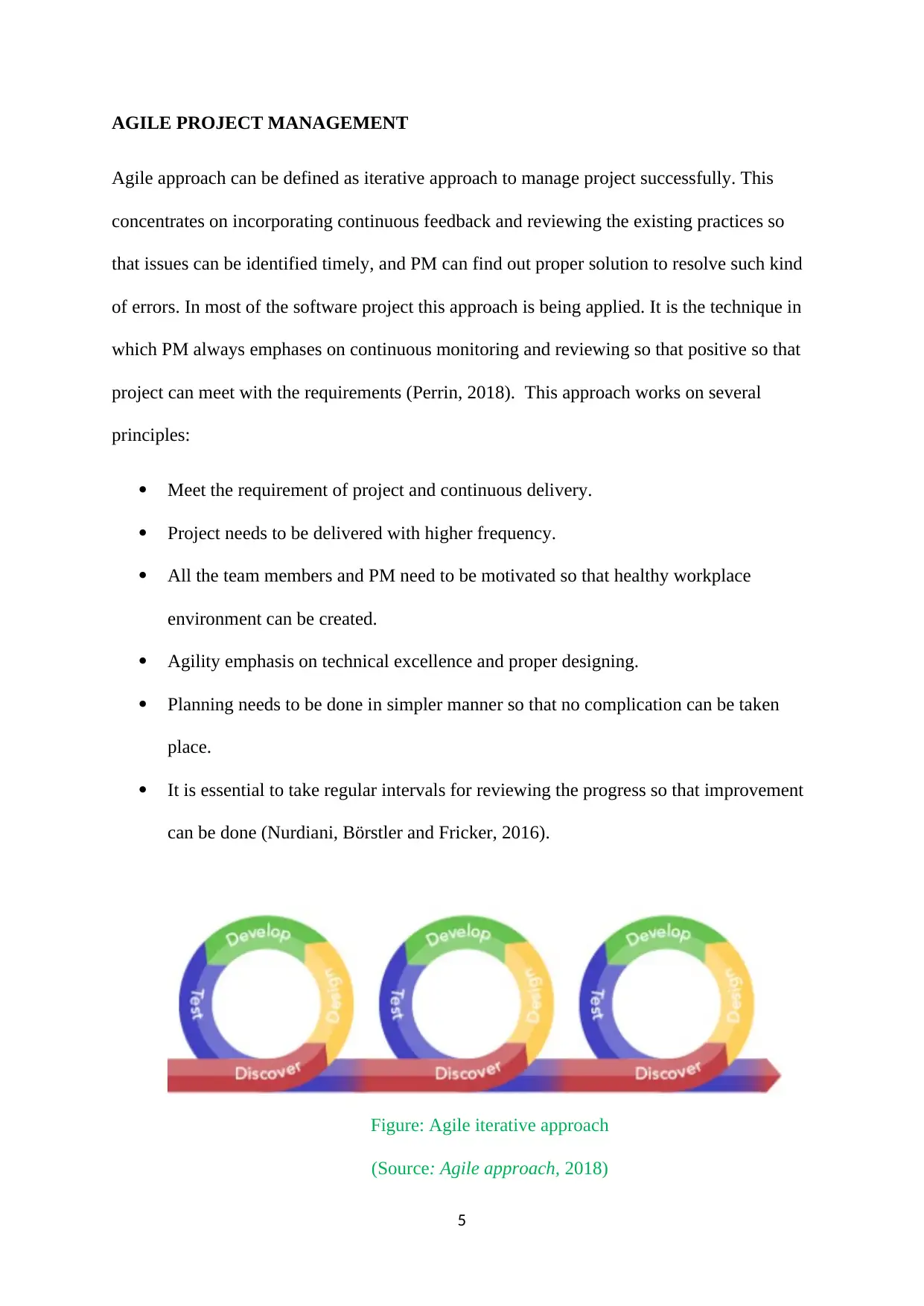
AGILE PROJECT MANAGEMENT
Agile approach can be defined as iterative approach to manage project successfully. This
concentrates on incorporating continuous feedback and reviewing the existing practices so
that issues can be identified timely, and PM can find out proper solution to resolve such kind
of errors. In most of the software project this approach is being applied. It is the technique in
which PM always emphases on continuous monitoring and reviewing so that positive so that
project can meet with the requirements (Perrin, 2018). This approach works on several
principles:
Meet the requirement of project and continuous delivery.
Project needs to be delivered with higher frequency.
All the team members and PM need to be motivated so that healthy workplace
environment can be created.
Agility emphasis on technical excellence and proper designing.
Planning needs to be done in simpler manner so that no complication can be taken
place.
It is essential to take regular intervals for reviewing the progress so that improvement
can be done (Nurdiani, Börstler and Fricker, 2016).
Figure: Agile iterative approach
(Source: Agile approach, 2018)
5
Agile approach can be defined as iterative approach to manage project successfully. This
concentrates on incorporating continuous feedback and reviewing the existing practices so
that issues can be identified timely, and PM can find out proper solution to resolve such kind
of errors. In most of the software project this approach is being applied. It is the technique in
which PM always emphases on continuous monitoring and reviewing so that positive so that
project can meet with the requirements (Perrin, 2018). This approach works on several
principles:
Meet the requirement of project and continuous delivery.
Project needs to be delivered with higher frequency.
All the team members and PM need to be motivated so that healthy workplace
environment can be created.
Agility emphasis on technical excellence and proper designing.
Planning needs to be done in simpler manner so that no complication can be taken
place.
It is essential to take regular intervals for reviewing the progress so that improvement
can be done (Nurdiani, Börstler and Fricker, 2016).
Figure: Agile iterative approach
(Source: Agile approach, 2018)
5
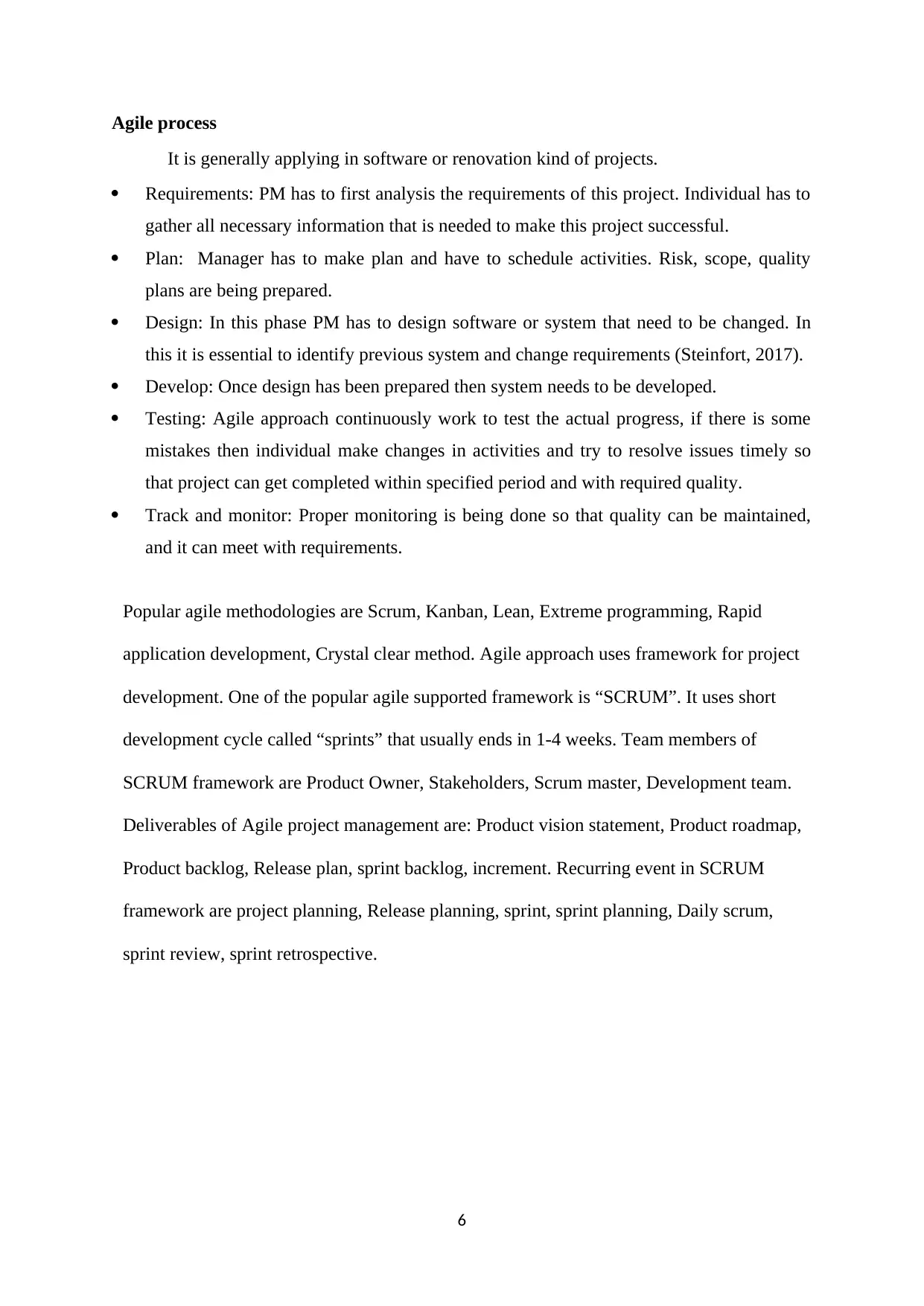
Agile process
It is generally applying in software or renovation kind of projects.
Requirements: PM has to first analysis the requirements of this project. Individual has to
gather all necessary information that is needed to make this project successful.
Plan: Manager has to make plan and have to schedule activities. Risk, scope, quality
plans are being prepared.
Design: In this phase PM has to design software or system that need to be changed. In
this it is essential to identify previous system and change requirements (Steinfort, 2017).
Develop: Once design has been prepared then system needs to be developed.
Testing: Agile approach continuously work to test the actual progress, if there is some
mistakes then individual make changes in activities and try to resolve issues timely so
that project can get completed within specified period and with required quality.
Track and monitor: Proper monitoring is being done so that quality can be maintained,
and it can meet with requirements.
Popular agile methodologies are Scrum, Kanban, Lean, Extreme programming, Rapid
application development, Crystal clear method. Agile approach uses framework for project
development. One of the popular agile supported framework is “SCRUM”. It uses short
development cycle called “sprints” that usually ends in 1-4 weeks. Team members of
SCRUM framework are Product Owner, Stakeholders, Scrum master, Development team.
Deliverables of Agile project management are: Product vision statement, Product roadmap,
Product backlog, Release plan, sprint backlog, increment. Recurring event in SCRUM
framework are project planning, Release planning, sprint, sprint planning, Daily scrum,
sprint review, sprint retrospective.
6
It is generally applying in software or renovation kind of projects.
Requirements: PM has to first analysis the requirements of this project. Individual has to
gather all necessary information that is needed to make this project successful.
Plan: Manager has to make plan and have to schedule activities. Risk, scope, quality
plans are being prepared.
Design: In this phase PM has to design software or system that need to be changed. In
this it is essential to identify previous system and change requirements (Steinfort, 2017).
Develop: Once design has been prepared then system needs to be developed.
Testing: Agile approach continuously work to test the actual progress, if there is some
mistakes then individual make changes in activities and try to resolve issues timely so
that project can get completed within specified period and with required quality.
Track and monitor: Proper monitoring is being done so that quality can be maintained,
and it can meet with requirements.
Popular agile methodologies are Scrum, Kanban, Lean, Extreme programming, Rapid
application development, Crystal clear method. Agile approach uses framework for project
development. One of the popular agile supported framework is “SCRUM”. It uses short
development cycle called “sprints” that usually ends in 1-4 weeks. Team members of
SCRUM framework are Product Owner, Stakeholders, Scrum master, Development team.
Deliverables of Agile project management are: Product vision statement, Product roadmap,
Product backlog, Release plan, sprint backlog, increment. Recurring event in SCRUM
framework are project planning, Release planning, sprint, sprint planning, Daily scrum,
sprint review, sprint retrospective.
6
⊘ This is a preview!⊘
Do you want full access?
Subscribe today to unlock all pages.

Trusted by 1+ million students worldwide

Figure: Agile project management with SCRUM framework
(Source: AGILE - SCRUM Project Management, 2018)
Comparison of project methods
Project management institute (PMI) describes that each project has temporary and PM
has to conduct entire task in such manner so that unique product can be created. PMBoK is
standard that is developed by PMI. This method always emphases on integration between
process and objectives. Project management body of knowledge divides the entire project
process into five phases: Initiative, Planning, execution, monitoring and controlling, closing
(Ferreira and et.al., 2017). PMBoK works on 10 knowledge areas:
PM has to ensure scope, time, cost, quality, risk in order to meet the overall
requirements. If these things are missing, then PM will not be able to accomplish the project
successfully and will get failed to meet the objective.
On other hand, Agile approach is far differed from PMBoK technique, It is also known
as SCRUM method. It uncovers effective ways to develop the software and find solution to
minimise errors. SCRUM is not a methodology it is the framework, it firsts identify the needs
7
(Source: AGILE - SCRUM Project Management, 2018)
Comparison of project methods
Project management institute (PMI) describes that each project has temporary and PM
has to conduct entire task in such manner so that unique product can be created. PMBoK is
standard that is developed by PMI. This method always emphases on integration between
process and objectives. Project management body of knowledge divides the entire project
process into five phases: Initiative, Planning, execution, monitoring and controlling, closing
(Ferreira and et.al., 2017). PMBoK works on 10 knowledge areas:
PM has to ensure scope, time, cost, quality, risk in order to meet the overall
requirements. If these things are missing, then PM will not be able to accomplish the project
successfully and will get failed to meet the objective.
On other hand, Agile approach is far differed from PMBoK technique, It is also known
as SCRUM method. It uncovers effective ways to develop the software and find solution to
minimise errors. SCRUM is not a methodology it is the framework, it firsts identify the needs
7
Paraphrase This Document
Need a fresh take? Get an instant paraphrase of this document with our AI Paraphraser
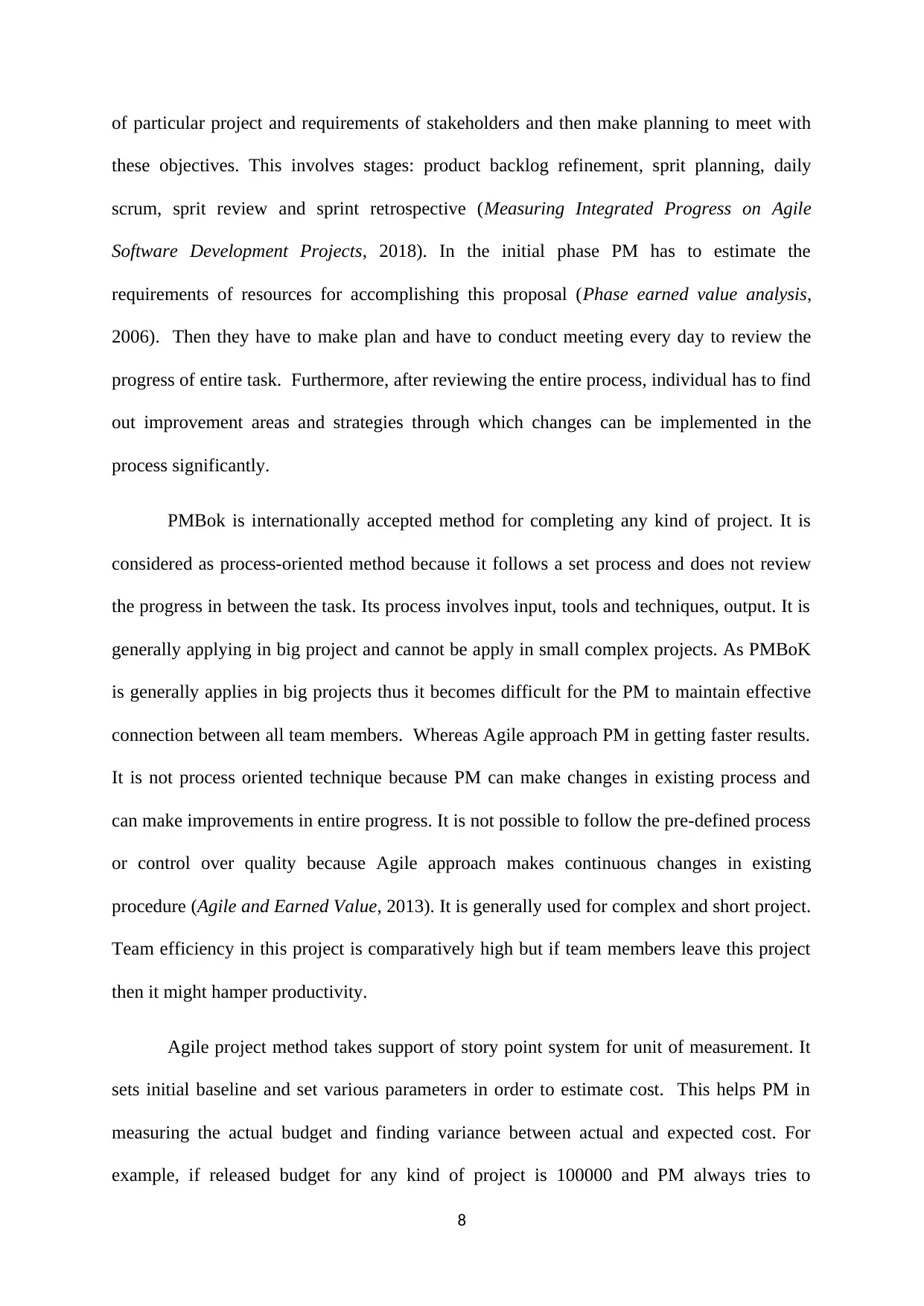
of particular project and requirements of stakeholders and then make planning to meet with
these objectives. This involves stages: product backlog refinement, sprit planning, daily
scrum, sprit review and sprint retrospective (Measuring Integrated Progress on Agile
Software Development Projects, 2018). In the initial phase PM has to estimate the
requirements of resources for accomplishing this proposal (Phase earned value analysis,
2006). Then they have to make plan and have to conduct meeting every day to review the
progress of entire task. Furthermore, after reviewing the entire process, individual has to find
out improvement areas and strategies through which changes can be implemented in the
process significantly.
PMBok is internationally accepted method for completing any kind of project. It is
considered as process-oriented method because it follows a set process and does not review
the progress in between the task. Its process involves input, tools and techniques, output. It is
generally applying in big project and cannot be apply in small complex projects. As PMBoK
is generally applies in big projects thus it becomes difficult for the PM to maintain effective
connection between all team members. Whereas Agile approach PM in getting faster results.
It is not process oriented technique because PM can make changes in existing process and
can make improvements in entire progress. It is not possible to follow the pre-defined process
or control over quality because Agile approach makes continuous changes in existing
procedure (Agile and Earned Value, 2013). It is generally used for complex and short project.
Team efficiency in this project is comparatively high but if team members leave this project
then it might hamper productivity.
Agile project method takes support of story point system for unit of measurement. It
sets initial baseline and set various parameters in order to estimate cost. This helps PM in
measuring the actual budget and finding variance between actual and expected cost. For
example, if released budget for any kind of project is 100000 and PM always tries to
8
these objectives. This involves stages: product backlog refinement, sprit planning, daily
scrum, sprit review and sprint retrospective (Measuring Integrated Progress on Agile
Software Development Projects, 2018). In the initial phase PM has to estimate the
requirements of resources for accomplishing this proposal (Phase earned value analysis,
2006). Then they have to make plan and have to conduct meeting every day to review the
progress of entire task. Furthermore, after reviewing the entire process, individual has to find
out improvement areas and strategies through which changes can be implemented in the
process significantly.
PMBok is internationally accepted method for completing any kind of project. It is
considered as process-oriented method because it follows a set process and does not review
the progress in between the task. Its process involves input, tools and techniques, output. It is
generally applying in big project and cannot be apply in small complex projects. As PMBoK
is generally applies in big projects thus it becomes difficult for the PM to maintain effective
connection between all team members. Whereas Agile approach PM in getting faster results.
It is not process oriented technique because PM can make changes in existing process and
can make improvements in entire progress. It is not possible to follow the pre-defined process
or control over quality because Agile approach makes continuous changes in existing
procedure (Agile and Earned Value, 2013). It is generally used for complex and short project.
Team efficiency in this project is comparatively high but if team members leave this project
then it might hamper productivity.
Agile project method takes support of story point system for unit of measurement. It
sets initial baseline and set various parameters in order to estimate cost. This helps PM in
measuring the actual budget and finding variance between actual and expected cost. For
example, if released budget for any kind of project is 100000 and PM always tries to
8
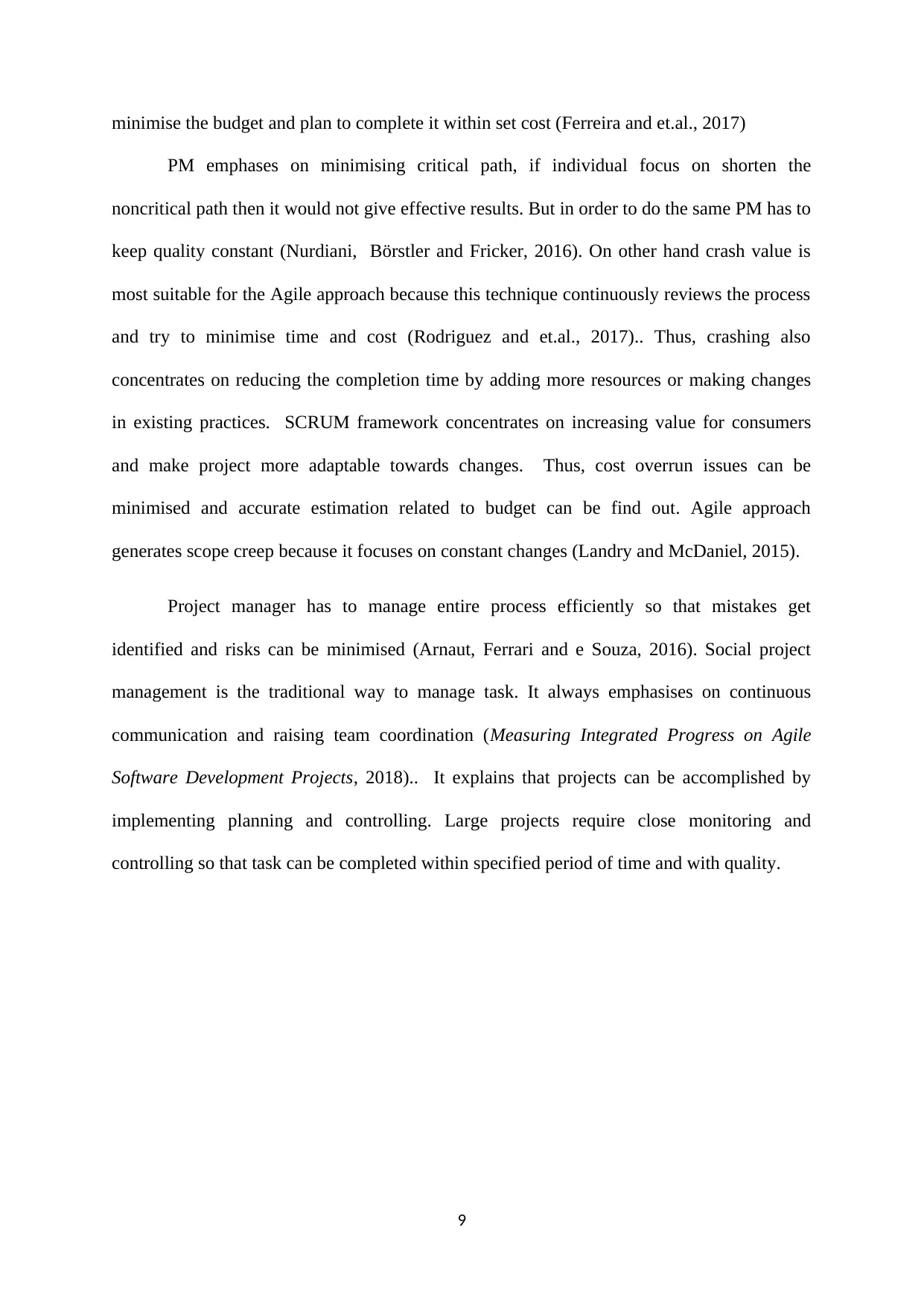
minimise the budget and plan to complete it within set cost (Ferreira and et.al., 2017)
PM emphases on minimising critical path, if individual focus on shorten the
noncritical path then it would not give effective results. But in order to do the same PM has to
keep quality constant (Nurdiani, Börstler and Fricker, 2016). On other hand crash value is
most suitable for the Agile approach because this technique continuously reviews the process
and try to minimise time and cost (Rodriguez and et.al., 2017).. Thus, crashing also
concentrates on reducing the completion time by adding more resources or making changes
in existing practices. SCRUM framework concentrates on increasing value for consumers
and make project more adaptable towards changes. Thus, cost overrun issues can be
minimised and accurate estimation related to budget can be find out. Agile approach
generates scope creep because it focuses on constant changes (Landry and McDaniel, 2015).
Project manager has to manage entire process efficiently so that mistakes get
identified and risks can be minimised (Arnaut, Ferrari and e Souza, 2016). Social project
management is the traditional way to manage task. It always emphasises on continuous
communication and raising team coordination (Measuring Integrated Progress on Agile
Software Development Projects, 2018).. It explains that projects can be accomplished by
implementing planning and controlling. Large projects require close monitoring and
controlling so that task can be completed within specified period of time and with quality.
9
PM emphases on minimising critical path, if individual focus on shorten the
noncritical path then it would not give effective results. But in order to do the same PM has to
keep quality constant (Nurdiani, Börstler and Fricker, 2016). On other hand crash value is
most suitable for the Agile approach because this technique continuously reviews the process
and try to minimise time and cost (Rodriguez and et.al., 2017).. Thus, crashing also
concentrates on reducing the completion time by adding more resources or making changes
in existing practices. SCRUM framework concentrates on increasing value for consumers
and make project more adaptable towards changes. Thus, cost overrun issues can be
minimised and accurate estimation related to budget can be find out. Agile approach
generates scope creep because it focuses on constant changes (Landry and McDaniel, 2015).
Project manager has to manage entire process efficiently so that mistakes get
identified and risks can be minimised (Arnaut, Ferrari and e Souza, 2016). Social project
management is the traditional way to manage task. It always emphasises on continuous
communication and raising team coordination (Measuring Integrated Progress on Agile
Software Development Projects, 2018).. It explains that projects can be accomplished by
implementing planning and controlling. Large projects require close monitoring and
controlling so that task can be completed within specified period of time and with quality.
9
⊘ This is a preview!⊘
Do you want full access?
Subscribe today to unlock all pages.

Trusted by 1+ million students worldwide
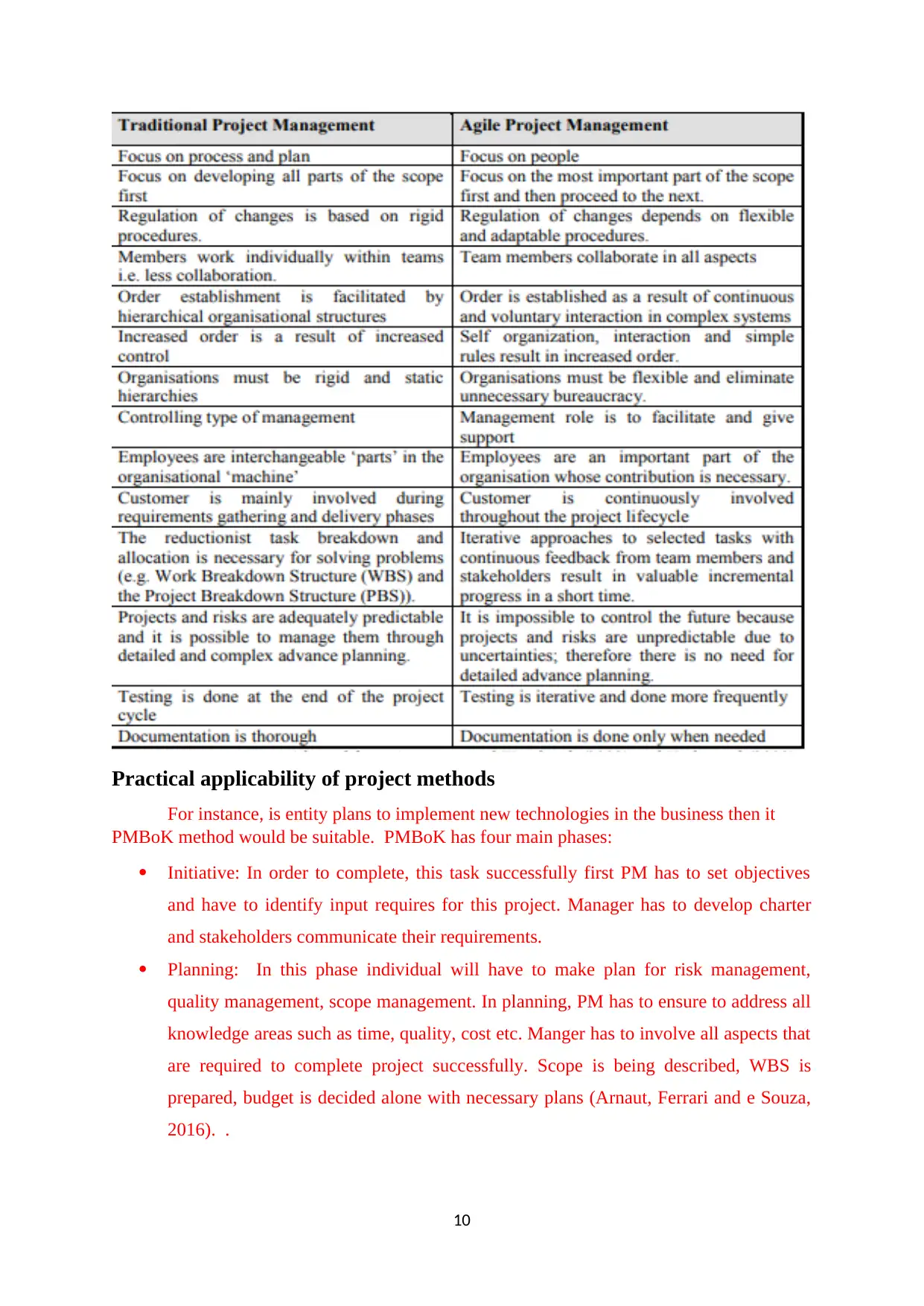
Practical applicability of project methods
For instance, is entity plans to implement new technologies in the business then it
PMBoK method would be suitable. PMBoK has four main phases:
Initiative: In order to complete, this task successfully first PM has to set objectives
and have to identify input requires for this project. Manager has to develop charter
and stakeholders communicate their requirements.
Planning: In this phase individual will have to make plan for risk management,
quality management, scope management. In planning, PM has to ensure to address all
knowledge areas such as time, quality, cost etc. Manger has to involve all aspects that
are required to complete project successfully. Scope is being described, WBS is
prepared, budget is decided alone with necessary plans (Arnaut, Ferrari and e Souza,
2016). .
10
For instance, is entity plans to implement new technologies in the business then it
PMBoK method would be suitable. PMBoK has four main phases:
Initiative: In order to complete, this task successfully first PM has to set objectives
and have to identify input requires for this project. Manager has to develop charter
and stakeholders communicate their requirements.
Planning: In this phase individual will have to make plan for risk management,
quality management, scope management. In planning, PM has to ensure to address all
knowledge areas such as time, quality, cost etc. Manger has to involve all aspects that
are required to complete project successfully. Scope is being described, WBS is
prepared, budget is decided alone with necessary plans (Arnaut, Ferrari and e Souza,
2016). .
10
Paraphrase This Document
Need a fresh take? Get an instant paraphrase of this document with our AI Paraphraser
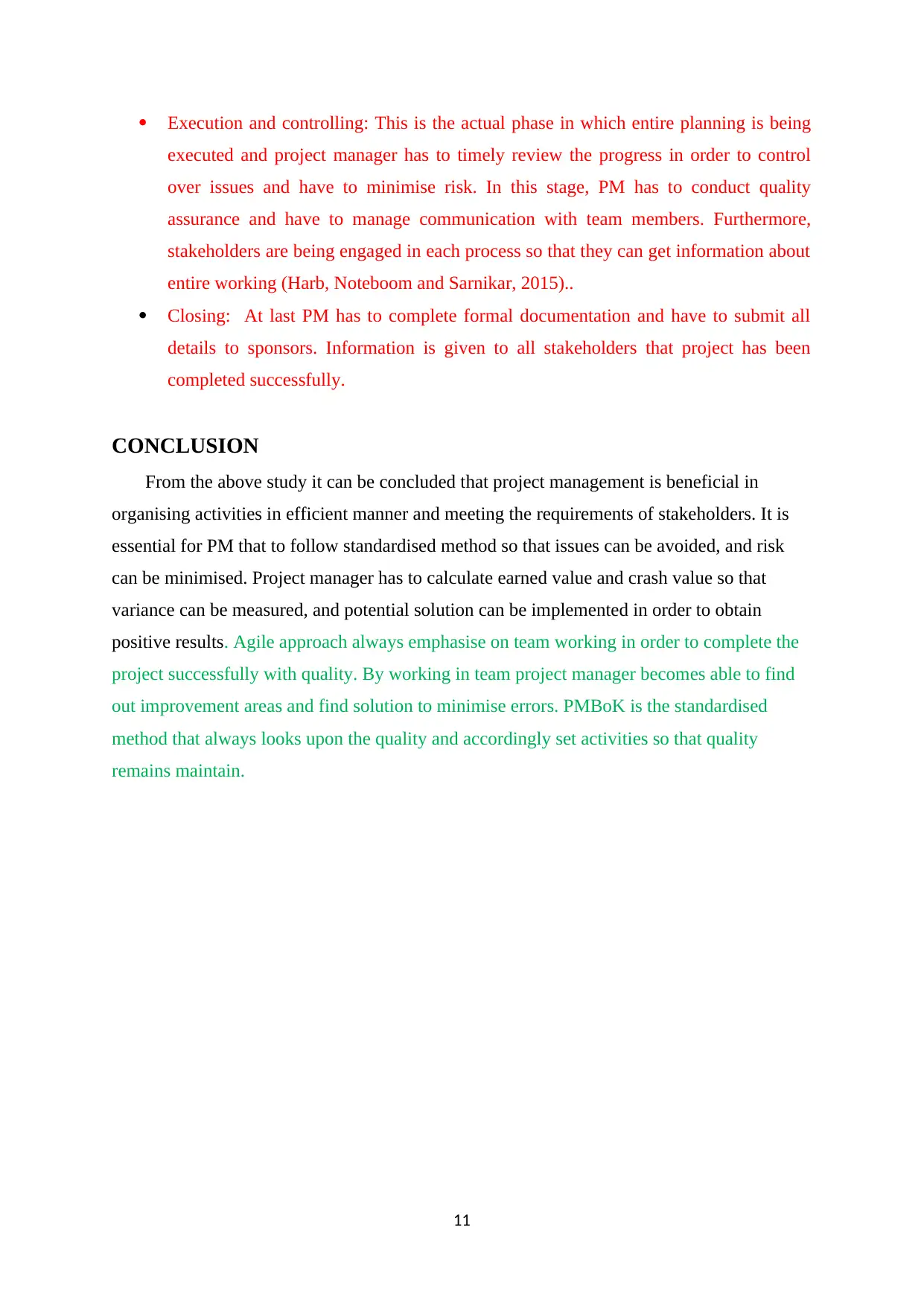
Execution and controlling: This is the actual phase in which entire planning is being
executed and project manager has to timely review the progress in order to control
over issues and have to minimise risk. In this stage, PM has to conduct quality
assurance and have to manage communication with team members. Furthermore,
stakeholders are being engaged in each process so that they can get information about
entire working (Harb, Noteboom and Sarnikar, 2015)..
Closing: At last PM has to complete formal documentation and have to submit all
details to sponsors. Information is given to all stakeholders that project has been
completed successfully.
CONCLUSION
From the above study it can be concluded that project management is beneficial in
organising activities in efficient manner and meeting the requirements of stakeholders. It is
essential for PM that to follow standardised method so that issues can be avoided, and risk
can be minimised. Project manager has to calculate earned value and crash value so that
variance can be measured, and potential solution can be implemented in order to obtain
positive results. Agile approach always emphasise on team working in order to complete the
project successfully with quality. By working in team project manager becomes able to find
out improvement areas and find solution to minimise errors. PMBoK is the standardised
method that always looks upon the quality and accordingly set activities so that quality
remains maintain.
11
executed and project manager has to timely review the progress in order to control
over issues and have to minimise risk. In this stage, PM has to conduct quality
assurance and have to manage communication with team members. Furthermore,
stakeholders are being engaged in each process so that they can get information about
entire working (Harb, Noteboom and Sarnikar, 2015)..
Closing: At last PM has to complete formal documentation and have to submit all
details to sponsors. Information is given to all stakeholders that project has been
completed successfully.
CONCLUSION
From the above study it can be concluded that project management is beneficial in
organising activities in efficient manner and meeting the requirements of stakeholders. It is
essential for PM that to follow standardised method so that issues can be avoided, and risk
can be minimised. Project manager has to calculate earned value and crash value so that
variance can be measured, and potential solution can be implemented in order to obtain
positive results. Agile approach always emphasise on team working in order to complete the
project successfully with quality. By working in team project manager becomes able to find
out improvement areas and find solution to minimise errors. PMBoK is the standardised
method that always looks upon the quality and accordingly set activities so that quality
remains maintain.
11
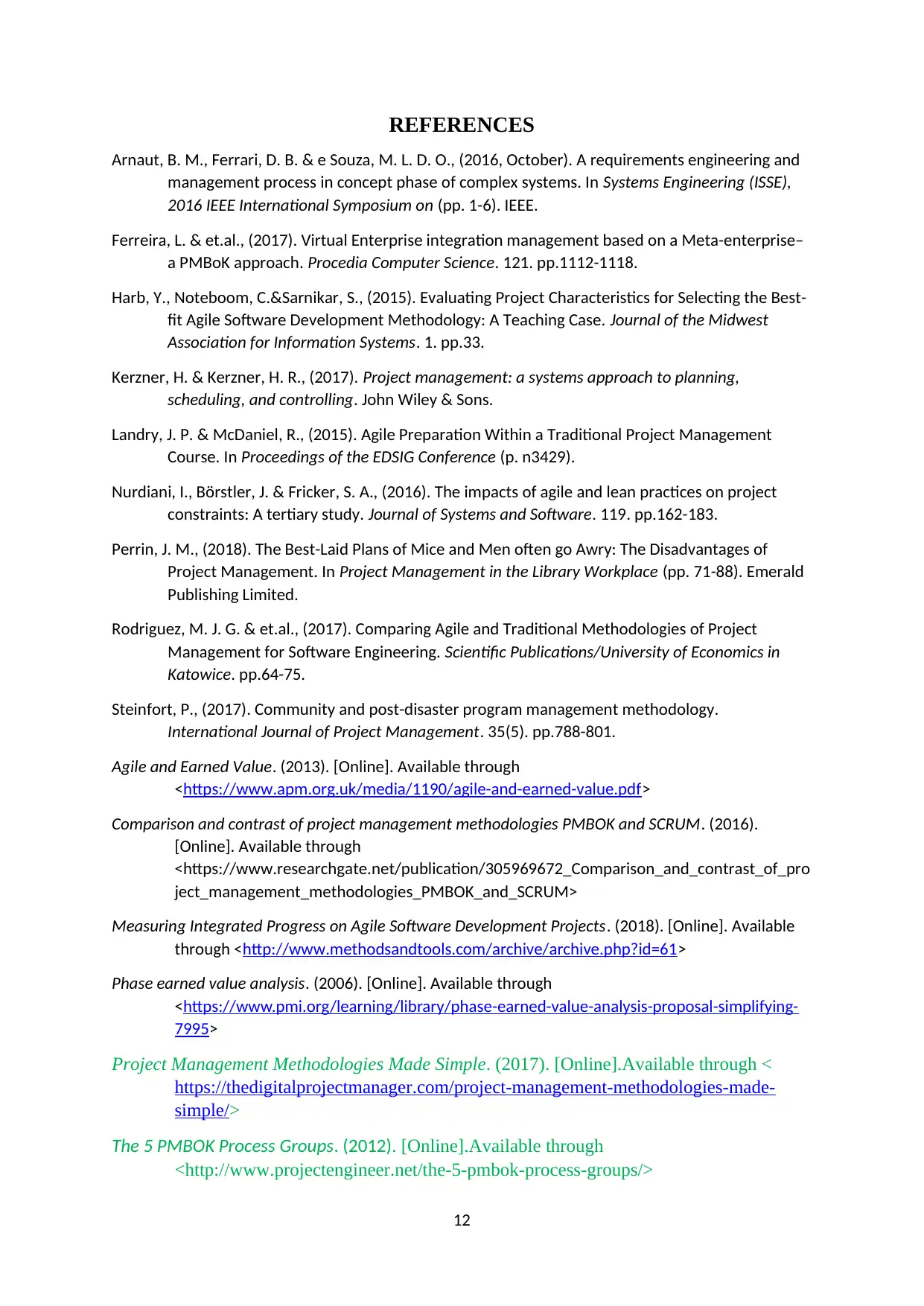
REFERENCES
Arnaut, B. M., Ferrari, D. B. & e Souza, M. L. D. O., (2016, October). A requirements engineering and
management process in concept phase of complex systems. In Systems Engineering (ISSE),
2016 IEEE International Symposium on (pp. 1-6). IEEE.
Ferreira, L. & et.al., (2017). Virtual Enterprise integration management based on a Meta-enterprise–
a PMBoK approach. Procedia Computer Science. 121. pp.1112-1118.
Harb, Y., Noteboom, C.&Sarnikar, S., (2015). Evaluating Project Characteristics for Selecting the Best-
fit Agile Software Development Methodology: A Teaching Case. Journal of the Midwest
Association for Information Systems. 1. pp.33.
Kerzner, H. & Kerzner, H. R., (2017). Project management: a systems approach to planning,
scheduling, and controlling. John Wiley & Sons.
Landry, J. P. & McDaniel, R., (2015). Agile Preparation Within a Traditional Project Management
Course. In Proceedings of the EDSIG Conference (p. n3429).
Nurdiani, I., Börstler, J. & Fricker, S. A., (2016). The impacts of agile and lean practices on project
constraints: A tertiary study. Journal of Systems and Software. 119. pp.162-183.
Perrin, J. M., (2018). The Best-Laid Plans of Mice and Men often go Awry: The Disadvantages of
Project Management. In Project Management in the Library Workplace (pp. 71-88). Emerald
Publishing Limited.
Rodriguez, M. J. G. & et.al., (2017). Comparing Agile and Traditional Methodologies of Project
Management for Software Engineering. Scientific Publications/University of Economics in
Katowice. pp.64-75.
Steinfort, P., (2017). Community and post-disaster program management methodology.
International Journal of Project Management. 35(5). pp.788-801.
Agile and Earned Value. (2013). [Online]. Available through
<https://www.apm.org.uk/media/1190/agile-and-earned-value.pdf>
Comparison and contrast of project management methodologies PMBOK and SCRUM. (2016).
[Online]. Available through
<https://www.researchgate.net/publication/305969672_Comparison_and_contrast_of_pro
ject_management_methodologies_PMBOK_and_SCRUM>
Measuring Integrated Progress on Agile Software Development Projects. (2018). [Online]. Available
through <http://www.methodsandtools.com/archive/archive.php?id=61>
Phase earned value analysis. (2006). [Online]. Available through
<https://www.pmi.org/learning/library/phase-earned-value-analysis-proposal-simplifying-
7995>
Project Management Methodologies Made Simple. (2017). [Online].Available through <
https://thedigitalprojectmanager.com/project-management-methodologies-made-
simple/>
The 5 PMBOK Process Groups. (2012). [Online].Available through
<http://www.projectengineer.net/the-5-pmbok-process-groups/>
12
Arnaut, B. M., Ferrari, D. B. & e Souza, M. L. D. O., (2016, October). A requirements engineering and
management process in concept phase of complex systems. In Systems Engineering (ISSE),
2016 IEEE International Symposium on (pp. 1-6). IEEE.
Ferreira, L. & et.al., (2017). Virtual Enterprise integration management based on a Meta-enterprise–
a PMBoK approach. Procedia Computer Science. 121. pp.1112-1118.
Harb, Y., Noteboom, C.&Sarnikar, S., (2015). Evaluating Project Characteristics for Selecting the Best-
fit Agile Software Development Methodology: A Teaching Case. Journal of the Midwest
Association for Information Systems. 1. pp.33.
Kerzner, H. & Kerzner, H. R., (2017). Project management: a systems approach to planning,
scheduling, and controlling. John Wiley & Sons.
Landry, J. P. & McDaniel, R., (2015). Agile Preparation Within a Traditional Project Management
Course. In Proceedings of the EDSIG Conference (p. n3429).
Nurdiani, I., Börstler, J. & Fricker, S. A., (2016). The impacts of agile and lean practices on project
constraints: A tertiary study. Journal of Systems and Software. 119. pp.162-183.
Perrin, J. M., (2018). The Best-Laid Plans of Mice and Men often go Awry: The Disadvantages of
Project Management. In Project Management in the Library Workplace (pp. 71-88). Emerald
Publishing Limited.
Rodriguez, M. J. G. & et.al., (2017). Comparing Agile and Traditional Methodologies of Project
Management for Software Engineering. Scientific Publications/University of Economics in
Katowice. pp.64-75.
Steinfort, P., (2017). Community and post-disaster program management methodology.
International Journal of Project Management. 35(5). pp.788-801.
Agile and Earned Value. (2013). [Online]. Available through
<https://www.apm.org.uk/media/1190/agile-and-earned-value.pdf>
Comparison and contrast of project management methodologies PMBOK and SCRUM. (2016).
[Online]. Available through
<https://www.researchgate.net/publication/305969672_Comparison_and_contrast_of_pro
ject_management_methodologies_PMBOK_and_SCRUM>
Measuring Integrated Progress on Agile Software Development Projects. (2018). [Online]. Available
through <http://www.methodsandtools.com/archive/archive.php?id=61>
Phase earned value analysis. (2006). [Online]. Available through
<https://www.pmi.org/learning/library/phase-earned-value-analysis-proposal-simplifying-
7995>
Project Management Methodologies Made Simple. (2017). [Online].Available through <
https://thedigitalprojectmanager.com/project-management-methodologies-made-
simple/>
The 5 PMBOK Process Groups. (2012). [Online].Available through
<http://www.projectengineer.net/the-5-pmbok-process-groups/>
12
⊘ This is a preview!⊘
Do you want full access?
Subscribe today to unlock all pages.

Trusted by 1+ million students worldwide
1 out of 13
Related Documents
Your All-in-One AI-Powered Toolkit for Academic Success.
+13062052269
info@desklib.com
Available 24*7 on WhatsApp / Email
![[object Object]](/_next/static/media/star-bottom.7253800d.svg)
Unlock your academic potential
Copyright © 2020–2025 A2Z Services. All Rights Reserved. Developed and managed by ZUCOL.





